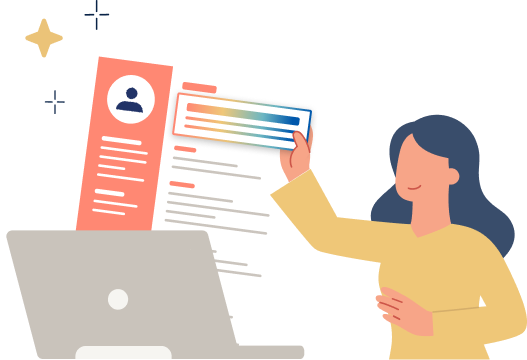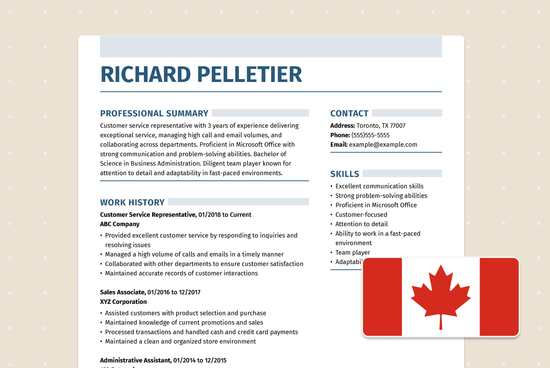Canadian Resume Format: Writing Guide & Examples

Our customers have been hired at: *Foot Note
Whether you’re moving north for new opportunities, remote work, or a fresh start, understanding how to write a Canadian-style resume can make all the difference in landing interviews.
In this guide, we’ll walk you through the must-have sections, formatting tips, and resume examples to help your application stand out to Canadian employers.
Let’s start building a resume that speaks their language—literally and professionally.
Canadian Resume Samples for Top Jobs
Start by checking out these Canadian resume examples:
Continue exploring how other job seekers highlight their qualifications with our professional resume examples for any industry and job title!
What to Include in a Canadian Resume
Writing a resume for a job in Canada is similar to writing one for a U.S.-based position.
Start by choosing a resume template appropriate for your target industry while showing off your personality. Then, go ahead and start writing!
Your Canadian resume template should include the following sections:
Resume header
Start with a large, noticeable resume header at the top. Include the following:
- Full name
- Phone number
- Professional website or digital portfolio, if applicable
- Networking profile
This section needs to be quick to find and easy to remember so that recruiters can find your resume and contact information without issues.
Professional statement
This is your elevator pitch. If the employer only reads one part of your resume, this will likely be it, so be sure to include all the necessary concisely.
Use a career summary if you’re an experienced candidate. Include your years of experience, strongest skill and an important accomplishment.
For example:
If you’re starting or changing careers, use a resume objective. It focuses on what you bring to the table, even without experience, and your short-term career goal for this role.
For example:
Your professional history
Beyond mentioning your title or past workplace, your work experience section should highlight and specify what you can bring to the table.
To write your work experience, include your title, the employer, location, and dates you worked.
Under each role, include quantifiable achievements that demonstrate your proactive attitude and ability to achieve positive outcomes.
Combine your work accomplishments with action verbs to make a stronger impact.
For example:
Physiotherapist
June 2021- Current
Central Hospital New Cityland, CA
- Increased patient satisfaction scores by 25% by implementing new treatment techniques and individualized care plans.
- Successfully treated over 100 patients with chronic back pain, resulting in a 75% reduction in pain and improved mobility.
- Developed and delivered a series of patient education workshops on injury prevention and management, resulting in a 30% reduction in re-injury rates.
If you’re concerned about writing a resume with no experience, there’s a lot more you can add besides work experience. According to Arrive, a Royal Bank of Canada (RBC) platform dedicated to helping newcomers to Canada with their careers, you can add volunteer experience.
The more relevant the tasks and responsibilities, the better. For example, volunteering as a web developer for a nonprofit organization is very relevant when applying for a programmer position.
Skills
The skills section will show the employer what you bring to the table. Create a balanced skills list by including relevant hard and soft skills.
Here are some skills examples for a software developer role:
Hard skills
- Data analytics
- AI intelligence proficiency
- Cybersecurity
- Digital communications
- Environmental stewardship
- Programming languages
- Project management
- Organizational development
- Sales
- Customer centricity
Soft skills
- Cross-cultural competence
- Diversity, equity, and inclusion (DEI) awareness
- Emotional intelligence
- Adaptability
- Continuous learning
- Critical thinking
- Time management
- Problem-solving
- Communication
- Creativity
Try our AI Resume Skills Generator to instantly get a tailored skills section for your desired role.
AI Resume Skills Generator

Education
For your education section, start with your highest degree, and include the institution’s name and your graduation date.
If you’re still finishing your education, add “In progress” or the expected completion date.
Canadian resumes list certifications under the education section, unlike their American counterparts, so ensure to include them if they’re relevant to the job you’re applying for.
See how it might look:
Criminology, Law and Society
Honours Bachelor of Arts, University of Toronto, June 2023
Additional sections
These sections can boost your resume and make you stand out from the competition:
- Volunteer experience: Demonstrates skills, commitment, community involvement, fills employment gaps, and reflects personal values. Choose relevant and meaningful experiences.
- Hobbies: Provide insight into your personality, interests, and skills that may apply to the job, showcasing a well-rounded candidate.
- Awards: Highlighting your distinctions shows your potential value to the company.
- Memberships: Your commitment to the industry, its value, ethics, and community are a must for employers.
- Foreign languages: With more than eight million immigrants from all over the world living in Canada, including foreign languages can show your ability to communicate with the diverse community.
Remember to always tailor these sections to the employer’s culture and needs.
Modify Your U.S. Resume for a Canadian Job
If you already have a U.S. resume, there is no need to start from scratch. With these few steps, you can transform your document into a bona fide Canadian resume.
- Use the Canadian Information Centre for International Credentials to find the Canadian equivalency for your educational, work and professional credentials. This step does not guarantee employment, it just moves the process along.
- Opt for a chronological format and keep the same sections as your U.S. resume.
- Use Canadian terminology and spelling to highlight your familiarity with the country and how it communicates.
- If you have the opportunity, consider tailoring your resume to the specific region or province in Canada where you are applying. Different regions may have different preferences or requirements, so it can be beneficial to customize your resume accordingly.
Looking for more international resumes? Try our:
Tips to Write a Canadian Resume
- Choose a resume format according to your career stage.
- Apply standard formatting for a professional resume: 1.5-inch margins, 10-12 font size for your content, and 12-14 font size for your heading.
- Include keywords from the job description throughout your document to pass ATS screens and get your resume to the hiring manager’s hands.
- Proofread and check grammar with the help of spell-checkers and other eyes.
- Keep your resume to one or two pages.
- Write a cover letter to complete an application and connect with employers on a human level.
Key Takeaways
- A Canadian resume is very similar to a U.S. resume. Stick to the standard resume sections and adjust your details to fit the target job.
- Use the Canadian Information Centre for International Credentials to validate your credentials for Canadian standards.
- Tailor your resume’s wording to Canadian terminology to show your familiarity with their way of communicating.
- Research the region’s preferences and requirements, and customize your resume accordingly.
FAQ
How can I navigate the Canadian job market as a foreigner?
The Canadian government provides resources, such as the program Canada InfoNet, to assist newcomers in navigating the intricacies of the Canadian job market.
Additionally, the Royal Bank of Canada (RBC) has developed Arrive, a platform that aids newcomers in starting their lives in Canada, including their job search and beyond. Building a robust professional network and seeking advice from career professionals through these programs can also be advantageous.
According to the Labour Force Survey, the biggest hurdles for newcomers are:
- Not having enough Canadian job experience (22.7%)
- Having no connections in the job market (20.3%)
- Lacking enough references from Canada (18.5%)
You can also register for Canada InfoNet, a platform that offers mentorship, coaching, and other career and employment tools for newly arrived candidates.
Once your visa and other immigration documents are approved, you can register for the program to receive the benefits and tools necessary to navigate the Canadian job market and its hurdles.
What is the Canadian job market like for a newcomer?
Canada’s job market is great for newcomers! It has a high demand for skilled professionals and immigration-friendly policies. A key aspect to take advantage of this job market is to start preparing before your move.
Prepare by:
- Improving your language
- Matching your credentials with the help of the Canadian Information Centre for International Credentials
- Seeking mentorship and networking opportunities.
Canada has the resources to assist your job seeking process, like the Job Bank, InfoNet and Arrive, among others.
How to make a Canadian cover letter?
To make a strong Canadian cover letter:
- Start with a strong opening: The first sentence of your cover letter should grab the employer’s attention and make them want to read more. Consider starting with a personal anecdote or a statement that shows your enthusiasm for the position.
- Highlight your qualifications in the body paragraphs: Use your cover letter to explain why you are the best candidate for the job. Highlight your relevant experience, skills and qualifications that match the job requirements.
- End with an open invitation: Finish your cover letter with a strong closing statement that reiterates your interest in the job and your availability for an interview.
You can use our Cover Letter Generator for additional help.
How we reviewed this article
Since 2012, we have helped more than 11 million job seekers. We want to make your career journey accessible and manageable through our services and Career Center’s how-to guides and tips. In our commitment to bring you a transparent process, we present our Editorial Process.
Sources
- Labour Statistics - Statistique Canada. Employment and unemployment
- CIC News. How to write a Canadian resume
- Arrive In. Resume Writing Tips for International Students in Canada
- Canada for Newbies. Canadian Resume Format
- Canadian College for Higher Studies Top skills in demand in the Canadian job market in 2024
- CTV News Looking for a job or career change? These skills will be in high demand in Canada in 2024
- Randstad. Article. No author. 11 trending skills Canadian employers want
- Moving2Canada. Article. No author. How to find a career mentor in Canada
- Moving 2 Canada. Guide. Transitioning to the Canadian job market
- Canada InfoNet Program Ready to Register?
- CIC News. Article. Moosapeta, Asheesh. The trends of immigrant employment in Canada
Our customers have been hired at:*Foot Note



